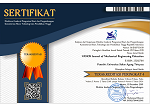GRAIN REFINEMENT TECHNIQUES TO REDUCE BIODEGRADATION RATE OF MAGNESIUM ALLOY AS A POTENTIAL BIODEGRADABLE IMPLANT MATERIAL: A REVIEW
Abstract
As a lightweight metal with mechanical properties similar to natural bone, magnesium-based material has been gaining wide popularity. However, the applications are seriously limited due to the excessively rapid degradation rate in the physiological environment, causing the magnesium to degrade faster than the complete rehabilitation of the bone itself. Grain refinement approach is currently the selected approach to obtain a lower degradation rate without adding other element that might be harmful to human body. This paper studies the possibility of reducing biodegradation rate of a biodegradable through reviewing various studies on grain refinement through hot deformation and rapid solidification.
Keywords
Full Text:
PDFReferences
Chaya, A., Yoshizawa, S., Verdelis, K., Myers, N., Costello, B. J., Chou, D.-T., Pal, S., Maiti, S., Kumta, P. N. & Sfeir, C. 2015. In vivo study of magnesium plate and screw degradation and bone fracture healing. Acta biomaterialia, 18, 262-269.
Gao, J., Guan, S., Ren, Z., Sun, Y., Zhu, S. & Wang, B. 2011. Homogeneous corrosion of high pressure torsion treated Mg–Zn–Ca alloy in simulated body fluid. Materials Letters, 65, 691-693.
Henderson, S. E., Verdelis, K., Maiti, S., Pal, S., Chung, W. L., Chou, D.-T., Kumta, P. N. & Almarza, A. J. 2014. Magnesium alloys as a biomaterial for degradable craniofacial screws. Acta biomaterialia, 10, 2323-2332.
Hermawan, H. Biodegradable Metals: From concept to applications. 2012. New York: Springer.
Izumi, S., Yamasaki, M. & Kawamura, Y. 2009. Relation between corrosion behavior and microstructure of Mg–Zn–Y alloys prepared by rapid solidification at various cooling rates. Corrosion Science, 51, 395-402.
Jinfeng, D., Guangsheng, H., Yanchun, Z. & Bei, W. 2014. Electrochemical performance of AZ31 magnesium alloy under different processing conditions. Rare Metal Materials and Engineering, 43, 316-321.
Keim, S., Brunner, J. G., Fabry, B. & Virtanen, S. 2011. Control of magnesium corrosion and biocompatibility with biomimetic coatings. Journal of Biomedical Materials Research Part B: Applied Biomaterials, 96, 84-90.
Kirkland, N. T. & Birbilis, N. 2014. Magnesium Biomaterials: Design, Testing, and Best Practice, Springer.
Kokubo, T. & Takadama, H. 2006. How useful is SBF in predicting in vivo bone bioactivity? Biomaterials, 27, 2907-2915.
Liao, J., Hotta, M. & Mori, Y. 2012. Improved corrosion resistance of a high-strength Mg–Al–Mn–Ca magnesium alloy made by rapid solidification powder metallurgy. Materials Science and Engineering: A, 544, 10-20.
Mueller, W.-D., Nascimento, M. L. & De Mele, M. F. L. 2010. Critical discussion of the results from different corrosion studies of Mg and Mg alloys for biomaterial applications. Acta biomaterialia, 6, 1749-1755.
Staiger, M. P., Pietak, A. M., Huadmai, J. & Dias, G. 2006. Magnesium And Its Alloys as orthopedic biomaterials: a review. Biomaterials, 27, 1728-1734.
Sunil, B. R., Ganapathy, C., Kumar, T. S. & Chakkingal, U. 2014a. Processing and mechanical behavior of lamellar structured degradable magnesium–hydroxyapatite implants. Journal of the mechanical behavior of biomedical materials, 40, 178-189.
Sunil, B. R., Kumar, T. S., Chakkingal, U., Nandakumar, V. & Doble, M. 2014b. Nano-hydroxyapatite reinforced AZ31 magnesium alloy by friction stir processing: a solid state processing for biodegradable metal matrix composites. Journal of Materials Science: Materials in Medicine, 25, 975-988.
Wang, J., Wang, L., Guan, S., Zhu, S., Ren, C. & Hou, S. 2010. Microstructure and corrosion properties of as sub-rapid solidification Mg–Zn–Y–Nd alloy in dynamic simulated body fluid for vascular stent application. Journal of Materials Science: Materials in Medicine, 21, 2001-2008.
Wang, Y., Wei, M., Gao, J., Hu, J. & Zhang, Y. 2008. Corrosion process of pure magnesium in simulated body fluid. Materials letters, 62, 2181-2184.
Wen, Z., Wu, C., Dai, C. & Yang, F. 2009. Corrosion behaviors of Mg and its alloys with different Al contents in a modified simulated body fluid. Journal of Alloys and Compounds, 488, 392-399.
Willbold, E., Kalla, K., Bartsch, I., Bobe, K., Brauneis, M., Remennik, S., Shechtman, D., Nellesen, J., Tillmann, W. & Vogt, C. 2013. Biocompatibility of rapidly solidified magnesium alloy RS66 as a temporary biodegradable metal. Acta biomaterialia, 9, 8509-8517.
Witte, F. 2015. Reprint of: The history of biodegradable magnesium implants: A review. Acta biomaterialia, 23, S28-S40.
Witte, F., Fischer, J., Nellesen, J., Crostack, H.-A., Kaese, V., Pisch, A., Beckmann, F. & Windhagen, H. 2006. In vitro and in vivo corrosion measurements of magnesium alloys. Biomaterials, 27, 1013-1018.
Witte, F., Hort, N., Vogt, C., Cohen, S., Kainer, K. U., Willumeit, R. & Feyerabend, F. 2008. Degradable biomaterials based on magnesium corrosion. Current opinion in solid state and materials science, 12, 63-72.
Yang, C., Yuan, G., Zhang, J., Tang, Z., Zhang, X. & Dai, K. 2010. Effects of magnesium alloys extracts on adult human bone marrow-derived stromal cell viability and osteogenic differentiation. Biomedical Materials, 5, 045005.
Zakiyuddin, A., Yun, K. & Lee, K. 2014. Corrosion behavior of as-cast and hot rolled pure magnesium in simulated physiological media. Metals and Materials International, 20, 1163-1168.
DOI: http://dx.doi.org/10.30870/vanos.v2i2.2923
Refbacks
- There are currently no refbacks.

This work is licensed under a Creative Commons Attribution 4.0 International License.


.png)
.png)
